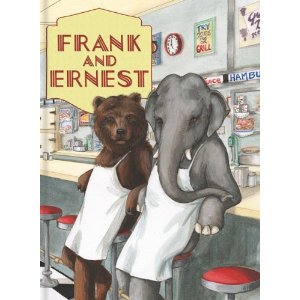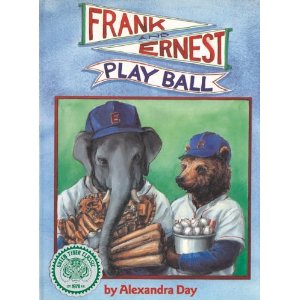 When I received a pitch from Laughing Elephant, publishers of Green Tiger Press titles, about a reprint of Alexandra Day’s Frank and Ernest, I was interested.
When I received a pitch from Laughing Elephant, publishers of Green Tiger Press titles, about a reprint of Alexandra Day’s Frank and Ernest, I was interested.
First off, the idea behind Green Tiger Press’s mission of bringing back out-of-print titles that have a classic look intrigued me as a worthy effort. What’s more, they are credited as “one of the driving forces behind the liberation of the picture book from the nursery . . .going so far as to eschew the assigning of age ranges to children’s books, a ubiquitous practice in publishing: ‘As if a nine year old shouldn’t read Where the Wild Things Are and no one over ten could possibly enjoy Caps for Sale, an absurd definition, and one that should be done away with,’ Harold Darling reflects, clearly still miffed by the practice.”
But the real hook was the beautiful artwork of Alexandra Day, which I learned is the pen name of Sandra Darling, who founded Green Tiger Press with her husband Harold.
When Amanda was a toddler and preschooler, Good Dog, Carl — the board book of course, since I have an irrational and inexplicable love for them — was always close at hand. She and I read it together (although it’s wordless, except for the beginning and the end pages), and she entertained herself with it. I remember being absolutely awed by Day’s artwork. Her paintings of the dog, the baby, and the household items are at once realistic and then also a thing of beauty. In reading this book, and sharing the beautiful mostly-wordless story, I felt as if I were introducing her to beauty — a beautiful and heart-warming story made even richer by the beautiful artwork.
Frank and Ernest is an almost oversized picture book at 8 x 11 inches, as if nothing less could contain this elephant and bear. Frank and Ernest first appear in the book dressed professionally in three-piece suits. They are hired to watch over Sally’s Diner. Because they are professionals, they make sure that they are up to par on the diner speak, and they exchange their suits for aprons. When one takes an order at the counter, he relays it to the other in the kitchen: “Paint a bow-wow red, Frank, and I need a nervous pudding,” Ernest shouts when someone orders a hot dog with ketchup and some Jell-O.
The plot is simple. Frank and Ernest do their job and share many orders with the funny language that has been developed, but that’s enough. My first-grader Kyle liked this book a lot (and my 7th-grader Amanda was seen looking at it more than once). I asked him what he liked about it so much, and he said told me that it was the “funny language.” In addition to being used in the story in context, there is a glossary printed on the front and back endpages. Wordplay is exciting to kids, and these words are silly to boot, which is generally a pretty good sell around here. I like the juxtaposition of a quiet story with the silliness of real language used in a strange way.
I began to wonder if there were other Frank and Ernest stories, because it seemed like they could easily step into other worlds on assignment, and when I was preparing this post, I noticed that Frank and Ernest Play Ball was re-released last month.
Jennifer Donovan frequented diners when she lived in New England, which were usually run by Greeks, not circus animals. She blogs more about where life has carried her at her blog Snapshot.

What a magnificent review- I want to go out and find this book immediately!
I agree with your assessment of Day’s illustrations, and we have a few Carl books in our own collection, too. (Talk about Free-Range Kid, huh??) 🙂
And I have to say that I LOVE the statement about age ranges for books- I know my own ten year old, who can read “above grade level,” still loves to join us for a picture book read, because there’s an appeal to a quality picture book that transcends age!
Yes, hopefully the over-protective parents of the world won’t have Carl the babysitter banned as a bad example!
And yes, though I used our customary “ideal age range” categories, because this book is simple and not overly plot-intensive, I could see a parent reading this to a pre-verbal youngster just because he/she liked it. And again — the artwork? Fantastic!